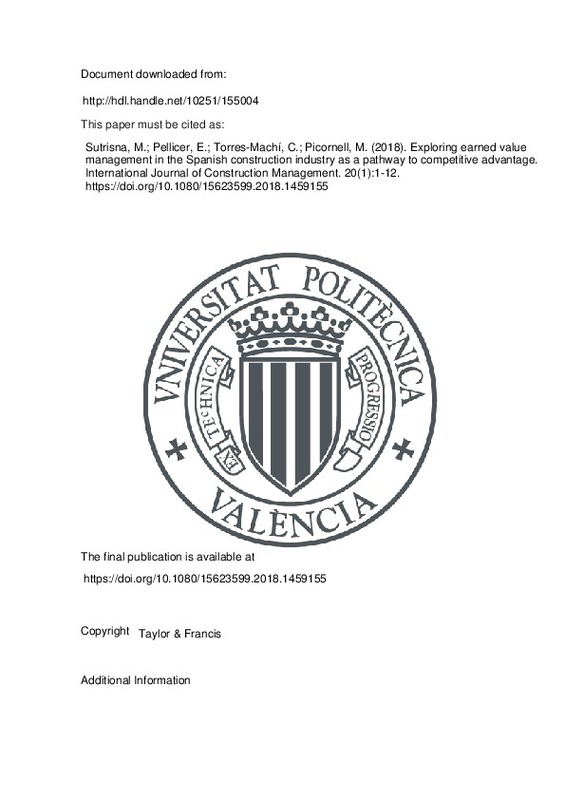Anbari, F. T. (2004). Earned value project management method and extensions. IEEE Engineering Management Review, 32(3), 97-97. doi:10.1109/emr.2004.25113
Aram, J. D., & Walochik, K. (1996). Improvisation and the Spanish Manager. International Studies of Management & Organization, 26(4), 73-89. doi:10.1080/00208825.1996.11656695
Brandon, D. M. (1998). Implementing Earned Value Easily and Effectively. Project Management Journal, 29(2), 11-18. doi:10.1177/875697289802900204
[+]
Anbari, F. T. (2004). Earned value project management method and extensions. IEEE Engineering Management Review, 32(3), 97-97. doi:10.1109/emr.2004.25113
Aram, J. D., & Walochik, K. (1996). Improvisation and the Spanish Manager. International Studies of Management & Organization, 26(4), 73-89. doi:10.1080/00208825.1996.11656695
Brandon, D. M. (1998). Implementing Earned Value Easily and Effectively. Project Management Journal, 29(2), 11-18. doi:10.1177/875697289802900204
Brown, A., & Adams, J. (2000). Measuring the effect of project management on construction outputs: a new approach. International Journal of Project Management, 18(5), 327-335. doi:10.1016/s0263-7863(99)00026-5
Bryde, D. J. (2003). Modelling project management performance. International Journal of Quality & Reliability Management, 20(2), 229-254. doi:10.1108/02656710310456635
Chen, H. L., Chen, W. T., & Lin, Y. L. (2016). Earned value project management: Improving the predictive power of planned value. International Journal of Project Management, 34(1), 22-29. doi:10.1016/j.ijproman.2015.09.008
De la Cruz, M. P., del Caño, A., & de la Cruz, E. (2006). Downside Risks in Construction Projects Developed by the Civil Service: The Case of Spain. Journal of Construction Engineering and Management, 132(8), 844-852. doi:10.1061/(asce)0733-9364(2006)132:8(844)
Din, S., Abd-Hamid, Z., & Bryde, D. J. (2011). ISO 9000 certification and construction project performance: The Malaysian experience. International Journal of Project Management, 29(8), 1044-1056. doi:10.1016/j.ijproman.2010.11.001
Eldin, N. N. (1989). Measurement of Work Progress: Quantitative Technique. Journal of Construction Engineering and Management, 115(3), 462-474. doi:10.1061/(asce)0733-9364(1989)115:3(462)
Gidado, K. I. (1996). Project complexity: The focal point of construction production planning. Construction Management and Economics, 14(3), 213-225. doi:10.1080/014461996373476
Hastak, M., Halpin, D. W., & Vanegas, J. (1996). COMPASS—New Paradigm for Project Cost Control Strategy and Planning. Journal of Construction Engineering and Management, 122(3), 254-264. doi:10.1061/(asce)0733-9364(1996)122:3(254)
D. Holt, G., & S. Goulding, J. (2014). Conceptualisation of ambiguous-mixed-methods within building and construction research. Journal of Engineering, Design and Technology, 12(2), 244-262. doi:10.1108/jedt-02-2013-0020
Ibbs, C. W., & Kwak, Y. H. (2000). Assessing Project Management Maturity. Project Management Journal, 31(1), 32-43. doi:10.1177/875697280003100106
Jugdev, K., & Thomas, J. (2002). 2002 Student Paper Award Winner: Project Management Maturity Models: The Silver Bullets of Competitive Advantage? Project Management Journal, 33(4), 4-14. doi:10.1177/875697280203300402
Kim, E., Wells, W. G., & Duffey, M. R. (2003). A model for effective implementation of Earned Value Management methodology. International Journal of Project Management, 21(5), 375-382. doi:10.1016/s0263-7863(02)00049-2
Kim, T., Kim, Y.-W., & Cho, H. (2016). Customer Earned Value: Performance Indicator from Flow and Value Generation View. Journal of Management in Engineering, 32(1), 04015017. doi:10.1061/(asce)me.1943-5479.0000377
Laufer, A., & Tucker, R. L. (1987). Is construction project planning really doing its job? A critical examination of focus, role and process. Construction Management and Economics, 5(3), 243-266. doi:10.1080/01446198700000023
Liberatore, M. J., Pollack-Johnson, B., & Smith, C. A. (2001). Project Management in Construction: Software Use and Research Directions. Journal of Construction Engineering and Management, 127(2), 101-107. doi:10.1061/(asce)0733-9364(2001)127:2(101)
Mir, F. A., & Pinnington, A. H. (2014). Exploring the value of project management: Linking Project Management Performance and Project Success. International Journal of Project Management, 32(2), 202-217. doi:10.1016/j.ijproman.2013.05.012
Navon, R., & Haskaya, I. (2006). Is detailed progress monitoring possible without designated manual data collection? Construction Management and Economics, 24(12), 1225-1229. doi:10.1080/01446190600999097
Onwuegbuzie, A. J., & Leech, N. L. (2005). Taking the «Q» Out of Research: Teaching Research Methodology Courses Without the Divide Between Quantitative and Qualitative Paradigms. Quality & Quantity, 39(3), 267-295. doi:10.1007/s11135-004-1670-0
Oviedo-Haito, R. J., Jiménez, J., Cardoso, F. F., & Pellicer, E. (2014). Survival Factors for Subcontractors in Economic Downturns. Journal of Construction Engineering and Management, 140(3), 04013056. doi:10.1061/(asce)co.1943-7862.0000811
Pellicer, E., Sanz, M. A., Esmaeili, B., & Molenaar, K. R. (2016). Exploration of Team Integration in Spanish Multifamily Residential Building Construction. Journal of Management in Engineering, 32(5), 05016012. doi:10.1061/(asce)me.1943-5479.0000438
Potts, K., & Ankrah, N. (2008). Construction Cost Management. doi:10.4324/9780203933015
Vanhoucke, M. (2012). Project Management with Dynamic Scheduling. doi:10.1007/978-3-642-25175-7
Yazici, H. J. (2009). The Role of Project Management Maturity and Organizational Culture in Perceived Performance. Project Management Journal, 40(3), 14-33. doi:10.1002/pmj.20121
Yu, A. G., Flett, P. D., & Bowers, J. A. (2005). Developing a value-centred proposal for assessing project success. International Journal of Project Management, 23(6), 428-436. doi:10.1016/j.ijproman.2005.01.008
[-]







![[Cerrado]](/themes/UPV/images/candado.png)


